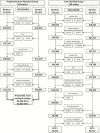Risk of Acute Myocardial Infarction Among Hepatitis C Virus (HCV)-Positive and HCV-Negative Men at Various Lipid Levels: Results From ERCHIVES
- PMID: 28444148
- PMCID: PMC5850566
- DOI: 10.1093/cid/cix359
Risk of Acute Myocardial Infarction Among Hepatitis C Virus (HCV)-Positive and HCV-Negative Men at Various Lipid Levels: Results From ERCHIVES
Abstract
Background: Risk of acute myocardial infarction (AMI) among hepatitis C virus (HCV)-positive versus HCV-negative persons with similar lipid levels is unknown. We determined incident AMI rates among HCV-positive and HCV-negative men among various lipid strata.
Methods: We created a propensity score matched (PSM) cohort and a low cardiovascular disease (CVD) risk cohort. Primary outcome was incident AMI rates by HCV status in each lipid strata using National Cholesterol Program guidelines for lipid strata.
Results: We identified 85863 HCV-positive and HCV-negative men in the PSM population. The incidence rates/1000 patient-years (95% confidence interval [CI]) for AMI among total cholesterol (TC) 200-239 stratum were 5.3 (4.89, 5.71) for HCV-positive versus 4.71 (4.42, 5) for HCV-negative men (P = .02) and for TC >240 mg/dL were 7.38 (6.49, 8.26) versus 6.17 (5.64, 6.71) (P = .02). For low-density lipoprotein cholesterol (LDL) of 130-159 mg/dL, AMI rates were 5.44 (4.97, 5.91) for HCV-positive and 4.81 (4.48, 5.14) for HCV-negative men (P = .03). The rise in risk with increasing lipid levels was greater in younger HCV-positive than in HCV-negative men (e.g., TC > 240 mg/dL: age >50 HR 1.38 [HCV-positive] and 1.12 [HCV-negative]; age ≤50 HR 1.6 [HCV-positive] and 1.29 [HCV-negative]), and more profoundly altered in HCV-positive men by lipid lowering therapy (change in HR with lipid-lowering therapy for TC >240 mg/dL from 1.82 to 1.19 [HCV-positive] from 1.48 to 1.03 [HCV-negative]).
Conclusions: HCV-positive men have a higher risk of AMI than HCV-negative men at higher TC/LDL levels; this risk is more pronounced at a younger age. Lipid lowering therapy significantly reduces this risk, with more profound reduction among HCV-positive versus HCV-negative men at similar lipid levels.
Keywords: ERCHIVES; acute myocardial infarction; cholesterol; hepatitis C virus; lipid.
© The Author 2017. Published by Oxford University Press for the Infectious Diseases Society of America. All rights reserved. For permissions, e-mail: journals.permissions@oup.com
Figures





Comment in
-
Hepatitis C Virus-Associated Alterations in Lipid and Lipoprotein Levels: Helpful or Harmful to the Heart?Clin Infect Dis. 2017 Aug 15;65(4):566-567. doi: 10.1093/cid/cix360. Clin Infect Dis. 2017. PMID: 28444147 Free PMC article. No abstract available.
Similar articles
-
Predictive value of lipoprotein indices for residual risk of acute myocardial infarction and sudden death in men with low-density lipoprotein cholesterol levels <120 mg/dl.Am J Cardiol. 2013 Oct 15;112(8):1063-8. doi: 10.1016/j.amjcard.2013.05.049. Epub 2013 Jul 4. Am J Cardiol. 2013. PMID: 23831165
-
Changes in circulating lipids level over time after acquiring HCV infection: results from ERCHIVES.BMC Infect Dis. 2015 Nov 11;15:510. doi: 10.1186/s12879-015-1268-2. BMC Infect Dis. 2015. PMID: 26558512 Free PMC article.
-
Impact of hepatitis C virus infection on long-term mortality after acute myocardial infarction: a nationwide population-based, propensity-matched cohort study in Taiwan.BMJ Open. 2018 Jan 26;8(1):e017412. doi: 10.1136/bmjopen-2017-017412. BMJ Open. 2018. PMID: 29374659 Free PMC article.
-
Association between hyperlipidemia and mortality after incident acute myocardial infarction or acute decompensated heart failure: a propensity score matched cohort study and a meta-analysis.BMJ Open. 2019 Dec 15;9(12):e028638. doi: 10.1136/bmjopen-2018-028638. BMJ Open. 2019. PMID: 31843818 Free PMC article.
-
Lowering Targeted Atherogenic Lipoprotein Cholesterol Goals for Patients at "Extreme" ASCVD Risk.Curr Diab Rep. 2019 Nov 21;19(12):146. doi: 10.1007/s11892-019-1246-y. Curr Diab Rep. 2019. PMID: 31754844 Review.
Cited by
-
Hepatitis C Infection Is Not a Cardiovascular Risk Factor in Young Adults.Biomedicines. 2024 Oct 20;12(10):2400. doi: 10.3390/biomedicines12102400. Biomedicines. 2024. PMID: 39457712 Free PMC article.
-
LncRNAs as Therapeutic Targets and Potential Biomarkers for Lipid-Related Diseases.Front Pharmacol. 2021 Aug 4;12:729745. doi: 10.3389/fphar.2021.729745. eCollection 2021. Front Pharmacol. 2021. PMID: 34421622 Free PMC article. Review.
-
The impact of infection with hepatitis C virus on cardiovascular risk.Am J Cardiovasc Dis. 2020 Aug 15;10(3):201-206. eCollection 2020. Am J Cardiovasc Dis. 2020. PMID: 32923102 Free PMC article. Review.
-
Global burden of atherosclerotic cardiovascular disease in people with hepatitis C virus infection: a systematic review, meta-analysis, and modelling study.Lancet Gastroenterol Hepatol. 2019 Oct;4(10):794-804. doi: 10.1016/S2468-1253(19)30227-4. Epub 2019 Jul 31. Lancet Gastroenterol Hepatol. 2019. PMID: 31377134 Free PMC article.
-
Metabolic Syndrome in HIV/HCV Co-infected Patients.Curr Treat Options Infect Dis. 2019 Dec;11(4):351-371. doi: 10.1007/s40506-019-00207-3. Epub 2019 Dec 2. Curr Treat Options Infect Dis. 2019. PMID: 32030090 Free PMC article.
References
-
- Roed T, Lebech AM, Kjaer A, Weis N. Hepatitis C virus infection and risk of coronary artery disease: a systematic review of the literature. Clin Physiol Funct Imaging 2012; 32:421–30. - PubMed
-
- Pothineni NV, Rochlani Y, Vallurupalli S et al. . Comparison of angiographic burden of coronary artery disease in patients with versus without hepatitis C infection. Am J Cardiol 2015; 116:1041–4. - PubMed
-
- Wong RJ, Kanwal F, Younossi ZM, Ahmed A. Hepatitis C virus infection and coronary artery disease risk: a systematic review of the literature. Dig Dis Sci 2014; 59:1586–93. - PubMed
MeSH terms
Substances
Grants and funding
LinkOut - more resources
Full Text Sources
Other Literature Sources
Medical
Miscellaneous

